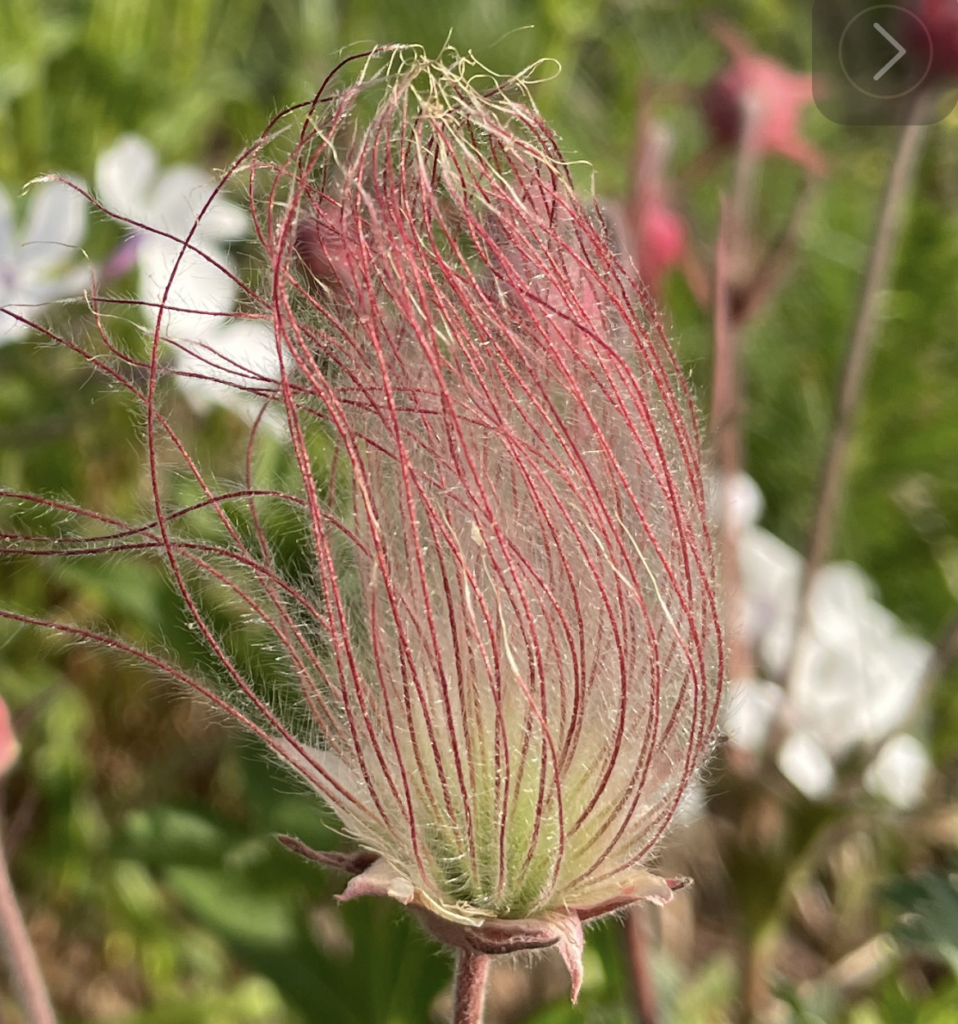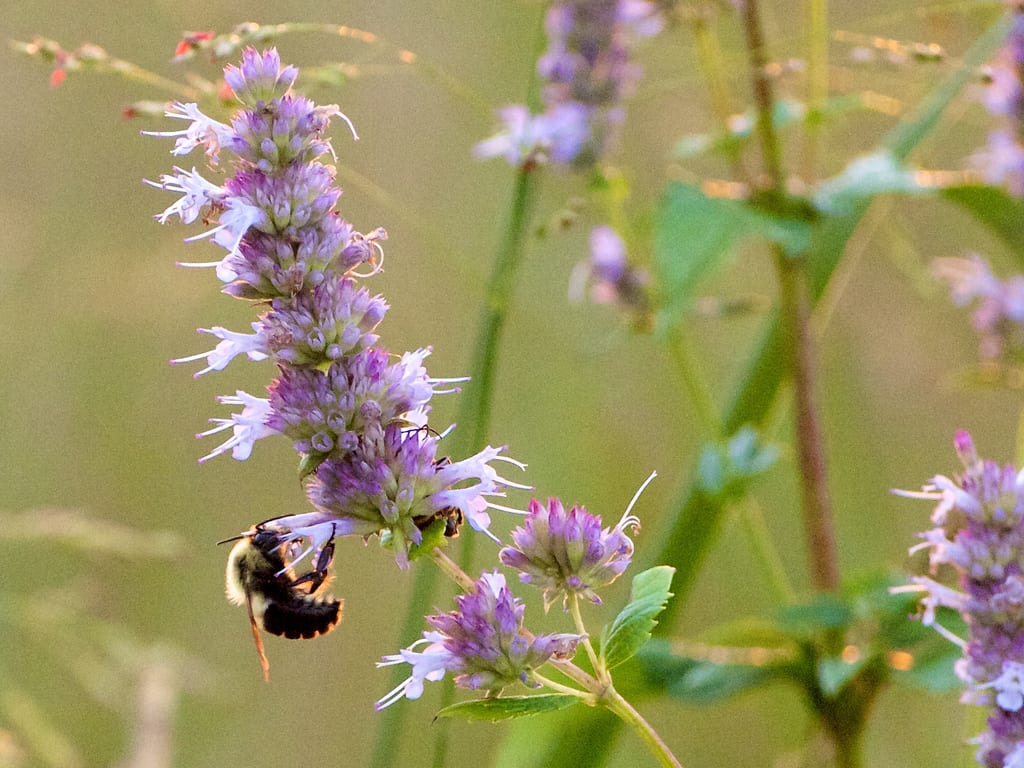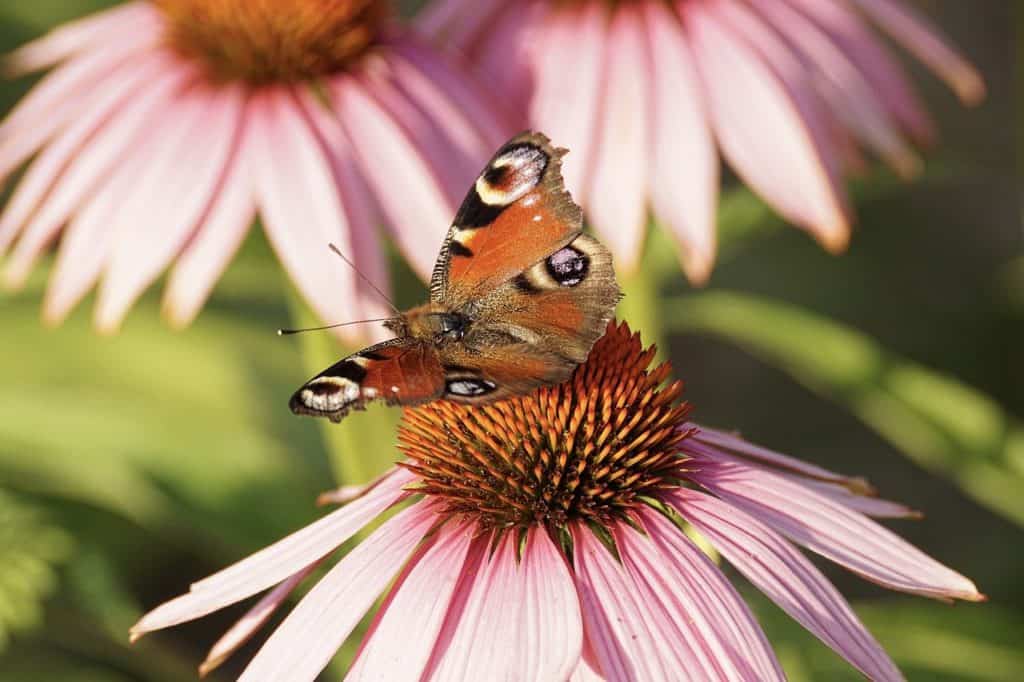Native Plant Profile: Geum triflorum (Prairie Smoke)
Common Name: Prairie Smoke
Scientific Name: Geum triflorum
Family: Rosaceae



Description:
Geum triflorum, commonly known as Prairie Smoke, is a distinctive herbaceous perennial native to North America. This plant is celebrated for its unique, nodding flowers that resemble puffs of smoke. These blooms emerge in the spring, showcasing a beautiful transition from pink to burgundy as they mature.
Following the flowering phase, Prairie Smoke produces feathery, elongated seedheads that persist into summer, maintaining visual interest in the garden even after the blooms have faded. These seedheads are particularly ornamental, adding texture and charm to any landscape.
Prairie Smoke typically reaches a height of 6 to 12 inches (15 to 30 cm) and spreads about 12 to 18 inches (30 to 45 cm) wide, making it an ideal choice for ground cover or as part of a mixed perennial border. Its foliage consists of basal rosettes of deeply lobed, fern-like leaves, which provide a lush and attractive backdrop to the delicate flowers, enhancing the plant’s overall aesthetic appeal.
Preferred Habitat and Native Region:
Prairie Smoke (Geum triflorum) thrives in open, sunny habitats where it can receive plenty of sunlight. Ideal environments include prairies, meadows, and open woodlands. These locations provide the well-drained soil conditions that Prairie Smoke prefers, allowing it to flourish without the risk of waterlogging.
Native to the central and western regions of North America, Prairie Smoke is commonly found across the Great Plains and the Rocky Mountains. Its range extends into parts of Canada, making it a versatile and hardy plant well-suited to a variety of climates and terrains within these areas. The plant’s adaptability to different environments underscores its resilience and suitability for natural landscaping and restoration projects in its native regions.
Propagation:
Prairie Smoke (Geum triflorum) can be propagated using seeds or by dividing established clumps, both of which are effective methods to encourage healthy growth and expansion in your garden.
Seed Propagation:
Seeds of Prairie Smoke require a period of cold stratification to successfully germinate. For best results, sow the seeds directly in the garden either in the fall or early spring. Sowing in fall allows the seeds to naturally undergo the cold stratification process over winter. If sowing in early spring, you may need to artificially stratify the seeds by placing them in a moist, cold environment (such as a refrigerator) for several weeks before planting. Once the seeds have been stratified, plant them in well-drained soil in a sunny location, and keep the soil consistently moist until germination occurs.
Propagation by Division:
Dividing established clumps of Prairie Smoke is another reliable propagation method. This can be done in early spring before new growth begins or in the fall after the growing season has ended. To divide, carefully dig up the clump and separate it into smaller sections, ensuring that each division has sufficient roots and foliage to support new growth. Replant the divisions promptly in their new location, maintaining proper spacing to allow for mature growth. Water the newly planted divisions well and continue to provide adequate moisture until they become established.
By using these propagation techniques, you can effectively increase the number of Prairie Smoke plants in your garden, ensuring a beautiful and sustainable display of this unique and attractive native perennial.
Aftercare:
Proper aftercare is essential for ensuring the health and beauty of Prairie Smoke (Geum triflorum). Here are some detailed guidelines to help you maintain this unique perennial:
Sunlight:
Prairie Smoke thrives best in full sun to partial shade. It flourishes in areas where it can receive at least 6 hours of direct sunlight daily. While it can tolerate some shade, this may result in fewer flowers and less vigorous growth. For optimal flowering and plant health, choose a location that provides ample sunlight.
Soil:
Prairie Smoke prefers well-drained soil with a sandy or loamy texture enriched with organic matter. However, it is highly adaptable and can grow in various soil types, including clay and gravelly soils. Good drainage is crucial to prevent root rot, so amend heavy soils with organic matter or sand to improve drainage if necessary.
Watering:
Once established, Prairie Smoke is drought-tolerant and requires minimal watering. However, regular watering is beneficial during prolonged periods of drought, especially in the first growing season to help the plant establish a robust root system. Water deeply but infrequently, allowing the soil to dry out between waterings to prevent overwatering.
Maintenance:
- Deadheading: Regularly remove spent flowers to encourage prolonged blooming and maintain the plant’s appearance. Deadheading prevents the plant from using energy to produce seeds, directing more energy toward flower production.
- Foliage Maintenance: Trim back faded or damaged foliage to keep the plant looking tidy and healthy. This also helps prevent disease and pest issues.
- Seedheads: The feathery, elongated seedheads of Prairie Smoke add visual interest to the garden even after the flowering season. Consider leaving some seedheads in place to enjoy their ornamental appeal through summer and into fall.
Fertilization:
Prairie Smoke generally does not require heavy fertilization. A light application of a balanced, slow-release fertilizer in early spring can support healthy growth. Avoid over-fertilizing, as this can lead to excessive foliage at the expense of flowers.
Mulching:
Apply a layer of organic mulch around the base of the plant to help retain soil moisture, regulate soil temperature, and suppress weeds. Mulching also adds organic matter to the soil as it decomposes, enhancing soil fertility and structure.
By following these aftercare tips, you can ensure that your Prairie Smoke plants remain healthy, vibrant, and a standout feature in your garden for years to come.
Companion Plants:
Pairing Prairie Smoke (Geum triflorum) with complementary plants enhances its beauty and contributes to a dynamic, biodiverse garden that supports local wildlife. Here are some excellent companion plants to consider:
Native Prairie Plants:
- Echinacea (Coneflowers): Known for their large, vibrant flowers, coneflowers attract pollinators such as bees, butterflies, and birds. Their striking blooms create a colorful contrast with the delicate nodding flowers of Prairie Smoke.
- Asclepias (Milkweeds): These essential pollinator plants are vital for monarch butterflies. Milkweeds’ upright, robust flower clusters provide a bold visual counterpoint to the more subtle Prairie Smoke, while both contribute to a pollinator-friendly environment.
- Rudbeckia (Black-eyed Susans): The bright yellow flowers of black-eyed Susans offer a cheerful addition to the garden, enhancing the overall visual appeal and attracting a variety of pollinators.
Ornamental Grasses:
- Panicum (Switchgrass): Switchgrass provides height and texture, its tall, airy plumes adding movement and a vertical element to the garden. The grass’s subtle hues and graceful form complement Prairie Smoke’s lower-growing, delicate flowers.
- Schizachyrium (Little Bluestem): This ornamental grass is prized for its blue-green foliage and striking fall color. Little Bluestem adds texture and seasonal interest, creating a beautiful backdrop for Prairie Smoke and helping to establish a natural, prairie-like setting.
Additional Companion Plants:
- Liatris (Blazing Star): Liatris offers spiky, purple flower spikes that rise above the garden, providing a dramatic contrast to the soft, nodding blooms of Prairie Smoke. They are also excellent for attracting pollinators.
- Coreopsis (Tickseed): Coreopsis produces masses of bright, daisy-like flowers that bloom profusely throughout the summer. Their sunny disposition pairs well with Prairie Smoke’s more muted tones, creating a lively, colorful display.
- Sedum (Stonecrop): These hardy succulents are perfect for filling gaps and adding interest with their unique foliage and late-season flowers. Sedum’s low-growing habit and drought tolerance make it an excellent companion for Prairie Smoke.
Benefits of Companion Planting:
- Biodiversity: A diverse planting scheme supports a wide range of pollinators, beneficial insects, and other wildlife, contributing to a healthy garden ecosystem.
- Visual Appeal: Combining plants with different heights, textures, and colors creates a visually appealing landscape that changes throughout the seasons.
- Soil Health: Companion plants can improve soil health by adding organic matter, fixing nitrogen, and preventing soil erosion through their varied root systems.
By thoughtfully selecting companion plants, you can enhance the beauty and ecological value of your Prairie Smoke plantings, creating a vibrant, sustainable garden that supports local wildlife and provides year-round interest.
Caution:
Non-Toxicity:
Geum triflorum (Prairie Smoke) is not known to be toxic to humans or pets when ingested in small quantities. However, as with any plant, it’s advisable to exercise caution and avoid consumption unless the plant is verified safe by a reliable source. If accidental ingestion occurs, monitor for any unusual symptoms and consult a medical professional or veterinarian if necessary.
General Safety Tips:
- Children and Pets: Although Prairie Smoke is generally considered safe, it’s always wise to teach children and pets not to consume plants or plant parts without adult supervision.
- Gardening Practices: When handling any plant, including Prairie Smoke, it’s a good practice to wear gloves to protect against potential skin irritation from soil or plant material.
Overall Benefits and Appeal:
Geum triflorum, commonly known as Prairie Smoke, is a charming and resilient perennial that offers numerous benefits for gardeners. Its unique nodding flowers, which resemble puffs of smoke, and attractive seedheads provide visual interest throughout the growing season. This plant is not only beautiful but also highly adaptable, thriving in a variety of garden conditions.
Unique Features:
- Distinctive Flowers: The nodding, smoke-like flowers of Prairie Smoke are a standout feature in any garden, transitioning from pink to burgundy as they mature.
- Ornamental Seedheads: After flowering, the plant produces feathery, elongated seedheads that persist into summer, adding texture and visual interest even after the blooms have faded.
- Adaptability: Prairie Smoke is well-suited to a range of soil types, including sandy, loamy, clay, and gravelly soils. Its ability to thrive in full sun to partial shade makes it a versatile choice for various garden settings.
Ideal for Native Plantings and Naturalized Landscapes:
Prairie Smoke is an excellent choice for native plantings and naturalized landscapes. Its low-maintenance nature, combined with its ecological benefits, makes it a valuable addition to sustainable gardens. By incorporating Prairie Smoke into your garden, you can:
- Support Pollinators: The flowers attract a variety of pollinators, including bees and butterflies, contributing to the health of your local ecosystem.
- Enhance Biodiversity: Planting native species like Prairie Smoke promotes biodiversity and helps create a balanced, resilient garden environment.
- Create Visual Interest: The plant’s unique flowers and seedheads, along with its fern-like foliage, provide year-round aesthetic appeal.
In summary, Geum triflorum (Prairie Smoke) is a delightful and hardy perennial that offers both beauty and functionality. Its non-toxic nature, combined with its adaptability and ecological benefits, makes it a standout choice for gardeners looking to enhance their landscapes with native plants.



